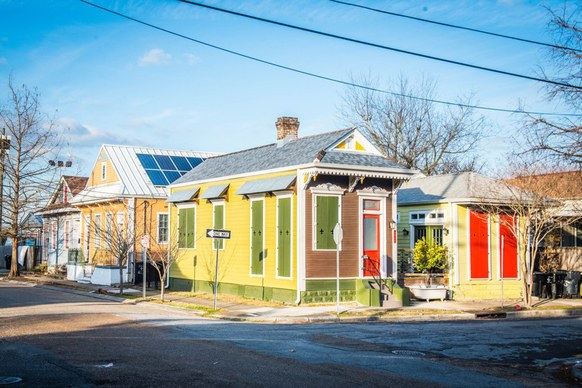This story originally appeared on CityLab and is part of the Climate Desk collaboration.
On a rainy day in New Orleans, people file into a beige one-story building on Jefferson Davis Parkway to sign up for the Low-Income Heating and Energy Assistance Program (LIHEAP), a federal grant that helps people keep up with their utility bills. New Orleans has one of the highest energy burdens in the country, meaning that people must dedicate a large portion of their income to their monthly energy bills. This is due in part to it being one of the least energy-efficient cities in the country.
For many city residents, these bills eat up 20 percent of the money they take in, and the weight of the burden can be measured in the length of the line.
“We’ve got folks wrapped around the block,” said Andreanecia Morris, the executive director of a housing advocacy non-profit called HousingNOLA. “There are people here paying 300, 400, 500 dollars a month. Some are paying utility bills that are as much as their mortgage.”
These bills, as indispensable as rent or healthcare, have exacerbated the affordability crisis as cities become increasingly inhospitable to all but the affluent. Energy costs increased at three times the rate of rent between 2000 and 2010. This rise, paralleling a dramatic stratification of wealth in some American cities, has widened the disparity in energy burdens between low-income and well-off households.
A 2016 study by the American Council for an Energy Efficient Economy (ACEEE) and Energy Efficiency for All (EEFA) set out to quantify what many already assumed: that low-income, black, and Hispanic communities spend a much higher share of their income on energy. The results were unsurprising, but stark. The researchers found that median energy burdens for low-income households are more than three times higher than among the rest of the population.
Utility bills are the primary reason why people resort to payday loans, and play an outsized role in the perpetuation of poverty. But the impacts of soaring energy bills go beyond finances. Living in under-heated homes puts occupants at a higher risk of respiratory problems, heart disease, arthritis, and rheumatism, according to ACEEE and EEFA. Then there are the tragedies, like that of Rodney Todd, a University of Maryland kitchen worker who died of monoxide poisoning, along with his seven children, while using a gas generator to power his home after his electricity was shut off by Delmarva Power.
One reason for the energy-burden gap is that the energy bills of the rich and poor aren’t in fact very different. “Energy is not discretionary,” said Anne Evens, CEO of Elevate Energy, an urban sustainability non-profit. No matter our income level, “We need energy to refrigerate our food, to heat our homes.”
Another cause, the 2016 study found, is that low-end housing is significantly less energy-efficient than other housing stock. People with less money aren’t just paying a greater proportion of their income for energy—they’re paying more per square foot. “Far from being an intractable problem related to persistent income disparity, the excess energy burdens [that low-income communities] face are directly related to the inefficiency of their homes,” the study authors concluded.
“What you’ll see is people finding cheaper rents in buildings because they’re older,” Morris said. “But their savings are offset, because their homes are so energy inefficient.”
There is a great amount of potential for energy savings in these older buildings. ACEEE and EEFA found that 97 percent of the excess energy burdens for renting households could be eliminated by bringing their homes up to median efficiency standards. And a 2015 study by the U.S. Department of Energy found that the value of energy upgrades is 2.2 times their cost. This figure is even higher for the most inefficient homes.
The question is how to find the capital to realize those gains, and whether the benefits can reach those who need relief.
Energy efficiency for some
Energy efficiency programs can go a long way to closing the energy burden gap, but they often do just the opposite.
A revolution in efficiency programs and home weatherization has opened the door to the world’s cheapest energy source: avoided energy waste. But for the most part, it is only accessible to people who can afford an upfront investment. Think of someone who’s renovating their kitchen and decides to replace the appliances with more energy-efficient ones, or a person who puts solar panels on the roof of his house, motivated less by cost savings and more by a bumptious desire to be the chief environmentalist on the block.


